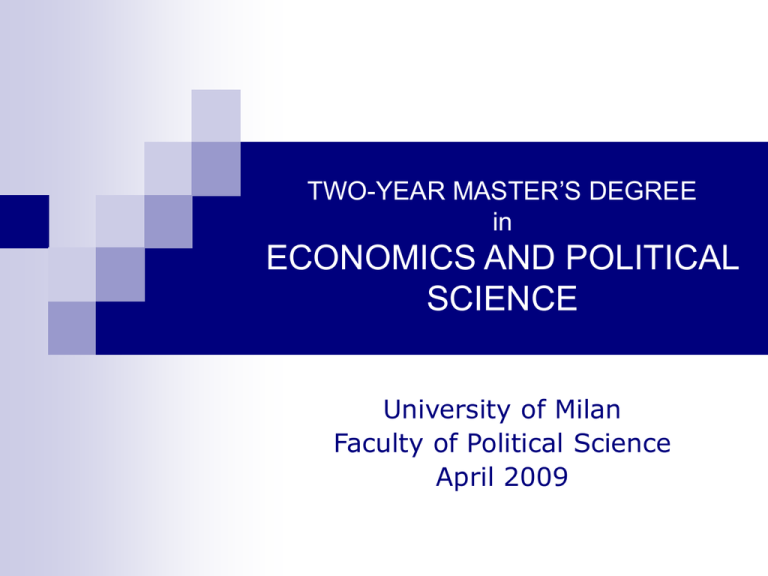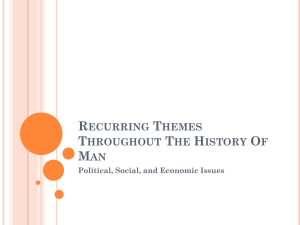
TWO-YEAR MASTER’S DEGREE
in
ECONOMICS AND POLITICAL
SCIENCE
University of Milan
Faculty of Political Science
April 2009
Overview
The two-year master’s degree in Economics and Political
Science (EPS) aims at developing a highly qualified
learning track in the fields of economics and political
science.
The design of the EPS programme is highly innovative in
the Italian university system.
Only the University of Milan offers a two-year master’s
degree in economics and political science.
The language of instruction is English.
April 2009
Economics and Political Science
2
Careers
The EPS programme is designed to train students in
advanced methodologies, analytical tools and
quantitative techniques used in all fields of economics
and political science.
EPS graduates will be ready to undertake a wide array
of career paths in:
multinational companies
political institutions
public organizations
all other professions demanding high intellectual
skills, robust technical competences and versatile
knowledge.
They will also be well prepared to engage in further
academic research in top PhD programmes.
April 2009
Economics and Political Science
3
About the 2009-2010 programme 1
The EPS programme is subdivided into two curricula:
Economic Analysis
and Policy (EAP) curriculum
or
Politics,
Philosophy and Public Policy (PPP) curriculum
The chief focus of the EAP curriculum is on economic
methods and problems.
The emphasis of the PPP curriculum is on political and
philosophical methods and issues.
April 2009
Economics and Political Science
4
About the 2009-2010 programme 2
Students will choose the curriculum when they
register, thus deciding which degree they will be
awarded upon completion of their studies:
either a master’s degree in economics (“laurea
magistrale in scienze dell’economia”),
or a master’s degree in political science (“laurea
magistrale in scienze della politica”).
Students will be able to change their curriculum choice
up to their registration as second-year students.
April 2009
Economics and Political Science
5
About the 2009-2010 programme 3
Regardless of curriculum choice, a common base of
shared learning activities will ensure the unity and
homogeneity of the programme.
Students must earn 120 ECTS credits to complete
programme requirements.
Compulsory coursework common to both curricula
amounts to 54 credits.
Another 33 credits are dedicated to additional
educational and research activities common to both
curricula.
Finally, 33 credits are allocated to coursework and
learning activities specific to each individual
curriculum.
April 2009
Economics and Political Science
6
Economic Analysis and Policy (EAP) Curriculum 1
Required courses - first year
Required courses - second year
Game theory
Macroeconomics
Markets, firms and organizations
Mathematics
Microeconomics
Philosophy, politics and welfare
Quantitative methods
Industrial organization
Positive political theory
Theories of regulation
Topics in economic analysis and policy
Other activities
April 2009
6
9
6
9
9
12
9
6
6
6
9
Computer skills, foreign language, internship or laboratory 3
Elective courses
9
Dissertation and research seminar
21
Economics and Political Science
7
Economic Analysis and Policy (EAP) Curriculum 2
EAP curriculum
17,5%
Economics
37,5%
Law
Philosophy
10%
Political Science
Quantitative Methods
Electives and others
15%
5%
10%
April 2009
Dissertation
5%
Economics and Political Science
8
Philosophy, Politics and Public Policy (PPP) Curriculum 1
Required courses - first year
Required courses - second year
Epistemology and political philosophy
Game theory
Mathematics
Microeconomics
Politics and welfare
Quantitative methods for the social sciences
Research methods in social and political science
Comparative politics
Democratic government and public administration
Positive political theory
Theories of regulation
Other activities
April 2009
12
6
6
9
12
9
6
6
6
Computer skills, foreign language, internship or laboratory 3
Elective courses
9
Dissertation and research seminar
21
Economics and Political Science
9
Philosophy, Politics and Public Policy (PPP) Curriculum 2
PPP curriculum
17,5%
12,5%
Economics
5%
10%
10%
Law
Philosophy
Political Science
Quantitative Methods
Electives and others
12,5%
32,5%
April 2009
Economics and Political Science
Dissertation
10
Entry requirements 1
The programme is intended for top level international
students. About 40 students are expected to enrol each year.
Non-resident candidates and all candidates (both resident
and non-resident) holding a degree awarded by non-Italian
universities may apply for admission to EPS from March 20 to
August 31, 2009.
Candidates residing in Italy and holding a degree awarded by
Italian universities may apply for admission to EPS from July
15 to September 15, 2009.
All relevant information concerning the admission procedures
is available online at www.scienzepolitiche.unimi.it/2010/EPS
April 2009
Economics and Political Science
11
Entry requirements 2
Admission is based on academic excellence. Applicants should
have:
a bachelor’s or higher degree (or equivalent);
a strong interest and/or previous studies in economics,
political science or related subjects;
undergraduate or graduate training in mathematics and
quantitative methods or a strong motivation to quickly fill
their gaps in these fields;
a sound knowledge of spoken and written English.
Applicants must have earned at least 60 ECTS credits (or
equivalent) in the following fields:
business administration, computer science, economics, law,
management, mathematics, philosophy, political science,
sociology or statistics.
April 2009
Economics and Political Science
12
Entry requirements 3
Non-native speakers of English must be able to demonstrate
their knowledge of English
either by showing they have at least one year of
university studies at institutions where the language of
instruction is English,
or by possessing one of the following certificates, with the
specified grades or scores:
April 2009
Cambridge CAE - Certificate in Advanced English (A, B)
Cambridge CPE - Certificate of Proficiency in English
(A, B, C)
Cambridge IELTS (at least 6)
TOEFL paper-based, computer-based or internet-based
(at least 550, 215, or 80, respectively)
Economics and Political Science
13
Entry requirements 4
Applicants meeting the above requirements will be invited
to an interview.
Non-resident candidates may be considered for telematic
interviews, if they apply by the appropriate deadline
(August 31, 2008).
Dates and times for telematic interviews will be arranged by
phone or e-mail.
Candidates residing in Lombardy or not applying for
telematic interviews will have to sit for on-site interviews.
On-site interviews will be held on September 17, 18, and
19, 2009, at the premises of the Faculty of Political Science,
Via Conservatorio, 7, Milan. A schedule will be posted online
immediately after the application deadline (September 15,
2009) has expired.
April 2009
Economics and Political Science
14
Entry requirements 5
Candidates lacking the requirement concerning the English
language will have to take an entrance test of English
before sitting for the interview.
Telematic entrance tests of English will take place at the
same time as the telematic interviews.
On-site entrance tests of English will be held on September
17, 2008, from 9.00 a.m. onwards, at the Faculty of
Political Science, Via Conservatorio 7, Milan, room 10.
The interviews aim at ascertaining both the applicants’
motivations and their personal knowledge, competences,
and skills in the core areas of immediate concern for the
EPS programme and chosen curriculum.
For an idea of the appropriate level of knowledge,
competences, and skills, candidates may consult the
following textbooks:
April 2009
Economics and Political Science
15
Entry requirements 6
Economics:
Blanchard O., Macroeconomics, 4th edition, Pearson
Prentice-Hall, Upper Saddle River, N.J., 2006.
Varian H., Intermediate Microeconomics. A Modern
Approach, 6th edition, Norton, New York, N.Y., 2003.
Political science:
April 2009
Dryzek J. S., B. Honig and A. Phillips, The Oxford
Handbook of Political Theory, Oxford University Press,
2006. Chapters:1, 6, 10, 16-17, 21-22, 24-25.
Lijphart A., Patterns of democracy: government forms
and performance in thirty-six countries, Yale University
Press, New Haven, London, 1999.
Stinebrickner R. B., Modern Political Analysis, PrenticeHall, Englewood Cliffs, 2002.
Economics and Political Science
16
Entry requirements 7
Quantitative methods (introductory calculus and linear algebra):
Haeusserl E. F., R. S. Paul, R. J. Wood, Introductory
Mathematical Analysis for Business, Economics, and the
Life and Social Sciences, 12th edition, Pearson Prentice
Hall, Upper Saddle River, 2008. Chapters: 0-6, 9-19.
Simon Carl. P. and Lawrence Blume, Mathematics for
Economists, W.W. Norton & Company, Inc., New York and
London, 1994. Chapters: 1-11.
April 2009
Economics and Political Science
17






